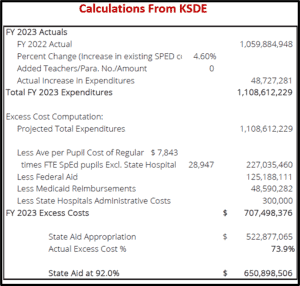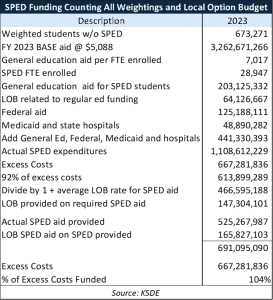If Benjamin Franklin were alive today, he would say there are four things certain in life: death, taxes, there will never be enough funding to satisfy Kansas education officials, and KASB will distort the truth.
 The Kansas Association of School Boards (KASB) claims school districts spent $382 million last year to cover the special education (SPED) shortfall. However, the Kansas Department of Education calculations show the state provided $522.9 million, or $128 million less than it says the state should have provided to reach 92% of excess costs of $650.9 million.
The Kansas Association of School Boards (KASB) claims school districts spent $382 million last year to cover the special education (SPED) shortfall. However, the Kansas Department of Education calculations show the state provided $522.9 million, or $128 million less than it says the state should have provided to reach 92% of excess costs of $650.9 million.
We asked KASB Executive Director Brian Jordan to share the math behind his $382 million claim. At press time, he had not responded.
As we’ve explained many times previously, the formula in statute does not count all of the state funding provided for special education.
Some, but not all, Local Option Budget funding is counted, and some, but not all, weightings are counted in determining the general education aid that is provided. The Kansas Department of Education cannot come up with any rationale for excluding some of the SPED funding, and the exclusion may be an error that’s been on the books undetected for many years.
 The law says the state should provide 92% of excess SPED costs (total costs less the amount provided for the general education of SPED students, federal SPED, Medicaid reimbursements, and state hospital administrative costs. The adjacent table uses KSDE data to recast the formula as if all funding counts, and it shows the state covered 101% of excess costs if all the SPED funding is counted.
The law says the state should provide 92% of excess SPED costs (total costs less the amount provided for the general education of SPED students, federal SPED, Medicaid reimbursements, and state hospital administrative costs. The adjacent table uses KSDE data to recast the formula as if all funding counts, and it shows the state covered 101% of excess costs if all the SPED funding is counted.
SPED aid should have been $613.9 million to meet the 92% threshold ($466.6 million in direct aid and $147.3 million of LOB funding generated by direct aid). Actual funding last year was $525.3 million, which generated $165.8 million in LOB funding.
It should also be noted that school districts started last year with $254 million in special education cash reserves – funding received in prior years but not spent. The balances held by many districts indicate that $254 million is considerably more than needed.
Also, the irony of school districts accusing the state of not following the SPED funding law is precious, given that most districts refuse to follow state laws on at-risk funding and building needs assessments.



